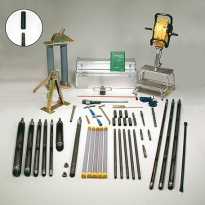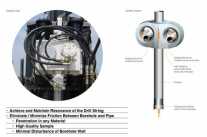Jostling drilling techniques
Jostling drilling techniques consist of a various amount of techniques described below.
Jostling drill with tubing
In this case the tubing exceeds until the desired drilling depth is reached. In the situation of investigation for environmental purposes the borehole should be covered completely after drilling. This is done to minimize the leaking of water into the borehole.
Conditions use jostling drill with tubing
| Parameters | Present |
|---|---|
| Contaminated | No |
| Used for environmental research | Yes |
| High cone resistance | No |
| Accurate description | No |
| Easy sealing | Yes |
| Sealing needed | No |
Jostling drill without tubing
In this case the tubing is not permanently or not present during drilling. This drilling technique can’t be used for environmental soil research due to three reasons: smearing takes place contaminating surrounding soils or water, the placing of monitoring wells is not possible after drilling and the borehole can’t be covered during the pull up of the drill.
In the case where no soil contamination is present and/or no samples for research need to be taken, above techniques can be combined. By jostling without tubing a borehole can be made which can be filled with an hollow tube in the hole after this the monitoring well can be placed with the right material on its outer wall. This concludes in the perfect circumstances for a borehole log.
In the case where soil contamination is present or samples for environmental research need to be taken it is advised that the whole borehole is covered after the drilling. If a filter is places, the borehole needs to be closed from the top of the filter.
There are three main jostling drill techniques, press drilling, hammer drilling and sonic drilling.
Conditions use jostling drill with tubing
| Parameters | Present |
|---|---|
| Contaminated | No |
| Used for environmental research | Yes |
| High cone resistance | No |
| Accurate description | No |
| Easy sealing | Yes |
| Sealing needed | Yes |
Press drilling
Press drilling is done with a CPT truck. There are two ways to take samples with this technique.
Tubed press drill
A relative thin tube with sharp point is pressed into the ground until the desired depth is reached. In this tube a very thin monitoring well is placed and then the tubing around is pulled up so only the filter remains. There needs to be a bentonite sealing present just above the filter and just beneath the ground level. This bentonite sealing needs to have a minimum thickness of 50 centimeters.
Conditions use jostling drill with tubing
| Parameters | Present |
|---|---|
| Contaminated | No |
| Used for environmental research | Yes |
| High cone resistance | No |
| Accurate description | No |
| Easy sealing | No |
| Fast sampling | No |
Probe press drill
A probe tube with an integrated filter part at the bottom is pressed into the ground until the desired depth is reached. Immediately after that a groundwater sample needs to be taken. After this the probe is pushed further and another groundwater sample is taken for a groundwater profile. This method is fit for indicative sampling and is due to the abundance of stabilization time between placing of the tube and sampling of the tube, not conform the NEN5744 and NEN5766.
With press drilling no samples can be taken in soils with a high probe resistance.
Conditions use jostling drill with tubing
| Parameters | Present |
|---|---|
| Contaminated | No |
| Used for environmental research | Yes |
| High cone resistance | No |
| Accurate description | No |
| Easy sealing | No |
| Fast sampling | Yes |
Hammer drilling
 Hammer drilling is done in the same circumstances as press drilling. The differences are that with hammer drilling the tube can be placed with lighter equipment than with press drilling. Also a wider diameter can be used for the tube, which results in a better environment for the placing of the monitoring well which can be sealed easily with bentonite in this case. The frequencies of hammering are very low, but the material load is very high with this technique. When layers with high cone resistance are encountered, drilling can be very time consuming or even impossible. A benefit from this technique is that due to the inertial effects of the hammering device, the soil samples are much longer and better for describing the soil profiles.
Hammer drilling is done in the same circumstances as press drilling. The differences are that with hammer drilling the tube can be placed with lighter equipment than with press drilling. Also a wider diameter can be used for the tube, which results in a better environment for the placing of the monitoring well which can be sealed easily with bentonite in this case. The frequencies of hammering are very low, but the material load is very high with this technique. When layers with high cone resistance are encountered, drilling can be very time consuming or even impossible. A benefit from this technique is that due to the inertial effects of the hammering device, the soil samples are much longer and better for describing the soil profiles.
Conditions use jostling drill with tubing
| Parameters | Present |
|---|---|
| Contaminated | No |
| Used for environmental research | Yes |
| High cone resistance | No |
| Accurate description | Yes |
Sonic drilling
 There are two ways of sonic drilling, namely: rotating sonic drilling and not rotating sonic drilling.
There are two ways of sonic drilling, namely: rotating sonic drilling and not rotating sonic drilling.
Not rotating sonic drilling
First the not rotating sonic drilling. With this technique the tubing is placed with the help of a sonic bore head including some or one oscillator which creates an up- and down going vibration between 50 and 160 Hz. This technique can be used in cohesive or non-cohesive soils and even used for sediment sampling. This technique has some difficulty with three different soil types, namely dry sands above the groundwater level, heavy clay soils and drilling through rocks.
Conditions use jostling drill with tubing
| Parameters | Present |
|---|---|
| Contaminated | No |
| Used for environmental research | Yes |
| High cone resistance | Yes |
| Rocks | No |
Rotating sonic drilling
Second the rotating sonic drilling. This technique uses both vibrations as rotation to drill through the layers beneath its sonic head. This technique can be used on every soil type even rocks. Dependable on the soil structure and sampling method, some water may be used for smearing and cooling when used under pressure. The use of this water when done properly doesn’t interfere with the environmental research. If the water is used under a higher pressure and with the purpose to speed up the drilling, then this technique is called spray- or flush drilling and can’t be used for environmental research.
The sampling will take place as open borehole sampling or as tubed borehole sampling.
Conditions use jostling drill with tubing
| Parameters | Present |
|---|---|
| Contaminated | No |
| Used for environmental research | Yes |
| High cone resistance | Yes |
| Rocks | Yes |
References
- NPR 5741:2014